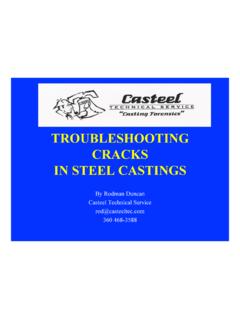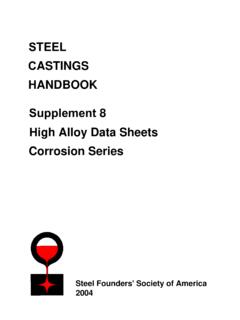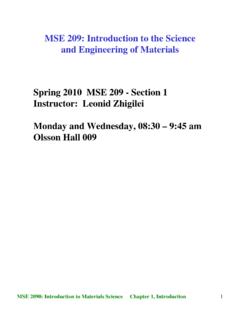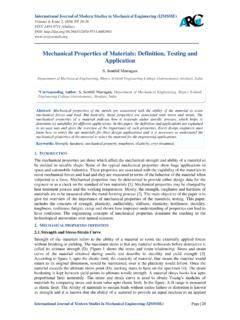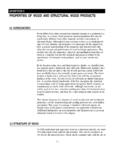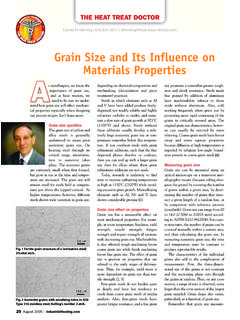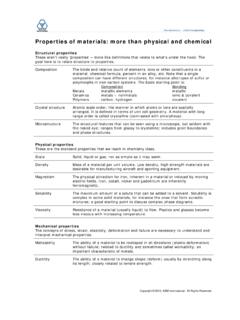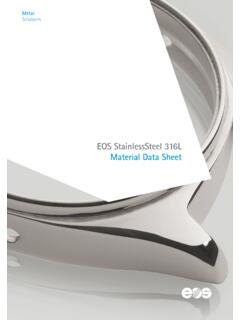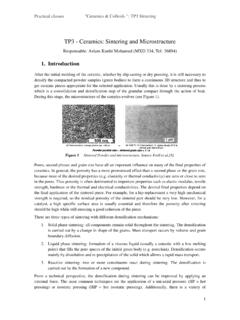Transcription of Carbon and Low Alloy Steel Casting Mechanical Properties
1 Steel Casting Mechanical Properties David Poweleit & Raymond Monroe Steel Founders Society of America, Crystal Lake, Illinois Carbon and low Alloy Steel castings are used in parts for railroad cars, pumps and valves, heavy trucks, construction and mining equipment, and power generation equipment. Good applications utilize the performance of Steel with the flexible geometry of a Casting . Steel castings offer high Mechanical Properties over a wide range of operating temperatures. Cast Steel offers the Mechanical Properties of wrought Steel and can be welded. Design Impact Casting offers freedom of geometry, so Casting part design plays a key role in Mechanical performance. Sections of a cast part subject to higher stress can be beefed up while low stress regions can be reduced. This flexibility facilitates a part with optimum performance and reduces weight; both minimize cost. One way to ensure the best Casting design is to work with a foundry on design.
2 A foundry will have the technical expertise to partner on the Casting the design and material selection. There are several rules of thumb to the development of a good Casting . First, reduce the number of isolated heavy sections and have smooth flowing transitions. It is feasible to cast any geometry but this may increase cost. Junctions within a Casting should be designed not to add mass. Changing section thickness in a Casting should be through smooth, easy transitions, adding taper and large radii help. Reducing undercuts and internal geometry help to minimize cost. The foundry and customer should agree upon tolerances. Specifying as-cast tolerances is also important in minimizing cost. Other post-processing such as machining and how the part will be held in a fixture also influence the final cost of the part. Datum points should be stated and machine stock should be added to required locations. Draft is the amount of taper or the angle, which must be allowed on all vertical faces of a Casting tool to permit its removal from the mold without tearing the mold walls.
3 Draft should be added to the design dimensions but metal thickness must be maintained. The amount of draft recommended under normal conditions is about degrees. Design resources and tutorials are available at Material Impact The chemical composition and microstructure of a Steel Casting determine its Mechanical Properties . Heat treatment can change microstructure and provide a wide range of Mechanical Properties . The response to heat treatment for a given section is hardenability. A Steel with a high hardenability will have uniform hardness in thicker sections, than ones with low hardenability. In general, adding alloying elements increases cost, improves some Properties , but may reduce others. Most elements will increase the hardenability of Steel . The effects of common alloying elements on Steel Properties are given in Table 1. Table 1: Effect of Alloying Element Element Effect on Steel Properties Carbon (C) Increases strength but decreases toughness and weldability (most common and important) Manganese (Mn) Similar, although lesser, affect as Carbon Silicon (Si) Similar to Carbon but with a lesser affect than manganese (important for castability) Nickel (Ni) Improves toughness Chromium (Cr) Improves oxidation resistance Molybdenum (Mo) Improves hardenability and high temperature strength Vanadium (V) Improves high temperature strength Tungsten (W) Improves high temperature strength Aluminum (Al) Reduces the oxygen or nitrogen in the molten Steel Titanium (Ti) Reduces the oxygen or nitrogen in the molten Steel Zirconium (Zi) Reduces the oxygen or nitrogen in the molten Steel Oxygen (O) Negative effect by forming gas porosity Nitrogen (N) Negative effect by forming gas porosity Hydrogen (H) In high quantities, results in poor ductility Phosphorus (P)
4 Can increase strength but drastically reduces toughness and ductility Sulfur (S) Reduces toughness and ductility When selecting a Steel , it is important to first know the required Properties . Carbon should be kept as low as possible to maximize weldability. Minimizing alloying elements to safely meet the performance requirements of the item will reduce cost. The foundry can provide assistance with material selection to ensure the appropriate Properties are purchased. Design Considerations Design requirements are typically determined in terms of strength or maximum stress. The design is commonly constrained by modulus, fatigue, toughness or ductility. Increasing the strength of Steel normally reduces the ductility, toughness, and weldability. It is often more desirable in Steel Casting design to use a lower strength grade and increase the section size or modify the shape. The design freedom makes castings an attractive way to obtain the best fabrication and material performance, and the needed component stiffness and strength.
5 When designing a part, it is important to understand the design limit so that proper material selection can be made. Stress, strain, fatigue, impact, wear, creep, and corrosion are all common service conditions that can impose design limits. Stress results from a Mechanical load carried by a component. The strength of a Steel is the measure of its load carrying ability. Loads can be applied and removed without deformation if they are small enough (elasticity). When a large enough load is applied, the material will stretch and deform permanently (plasticity). Plastic deformation starts to occur when the yield strength is exceeded. The maximum load that can be applied before the material fractures, is the ultimate tensile strength. Designers need to ensure that the part will not break or permanently deform. Thus, it is important to design a Casting for stress levels below the yield strength or in the elastic region of the part. Typically1/2 the yield strength is used for safety, but 2/3 can be utilized with a thorough evaluation.
6 The strength of Steel depends on the composition and heat treatment. Steel is iron-based alloyed mainly with Carbon . Other alloying elements add strength but are also important in determining how effectively the Steel grade will respond to heat treatment. Heat treatment rearranges the crystal structure of the iron and the distribution of Carbon . Slow cooling rates produce coarse microstructures , which have lower strength. Cooling slowly in the furnace is called annealing and is not commonly used, except as an intermediate treatment to allow some grades to be machined. Cooling in still air is called normalizing and is the most common treatment providing good strength and ductility. Rapidly cooling in water or oil is known as quenching. Steel must be reheated or tempered after quenching to improve ductility. Quenching and tempering gives the highest strength available from any grade. Varying the tempering temperature and time allows the production of a wide range of final strength levels with a quenched and tempered grade.
7 Strain is the amount of stretching in a loaded component. The ability to absorb strain without fracture is critical to safety and reliability. Steel can be bent, twisted, or stretched without breaking. Strain is measured by determining the amount of permanent stretch, plastic deformation, in the tensile bar test. The increase in length is the elongation and the change in area at the point of fracture of the bar is the reduction of area. The ability to stretch without cracking is called ductility. In general, increasing the strength of a Steel grade reduces its ductility. While most designers think in terms of the material s strength, most of the production of Steel is in the lower strength grades, which have good ductility. Carbon content and heat treatment influence strength and ductility; shown in Figure 1. Carbon contents are typically kept well below to avoid problems with cracks in heat treating or welding. The relationship between the ratio of stress to strain is the elastic modulus.
8 Data is derived from a tensile test. The modulus of elasticity is based solely on the material, heat treatment does not affect modulus. Steels have a modulus of approximately 30 x 106 psi. Steels have the highest modulus of elasticity of commonly used materials. The larger the modulus the smaller the deflection of a part; Steel provides good stiffness. Figure 1: Cast low Alloy Steel Properties at room temperature Figure 2: Cast and wrought 8600 series Steel fatigue Properties Fatigue is the failure of a component when it is repeatedly loaded, even at levels well below the yield strength of the Steel . It is measured by repeated loadings of several bars at different stress levels and determining the number of cycles to failure. A typical result of the stress versus cycles is shown in Figure 2. Low cycle fatigue is below 100,000 loadings where ductility is needed. High cycle fatigue is normally above 1,000,000 loadings and high strength is required.
9 Impact affects the Steel s ability to resist fracture or cracking during service. The Steel 's ability to resist cracking at low temperatures or during impact loading is known as toughness. Toughness is measured by the amount of energy required to break the material at a certain temperature. A common test which measures toughness is the Charpy impact test. Like ductility, toughness tends to fall as the strength of the material increases. The reduction in toughness at higher Carbon contents for two heat treatments is shown in Figure 3. Wear occurs when materials rub against each other under load and material is lost from the contacted surface. There is no standard test for wear resistant materials. Gouging, abrasion, impact, and corrosion must be considered in different types of applications. Typically, harder materials resist wear better. Since hardness increases with strength, higher Carbon , higher strength steels are commonly used. It is important to retain adequate toughness at the high hardness levels to avoid cracking and premature failures.
10 Figure 3: Cast Carbon Steel Charpy V-notch Properties at room temperature Creep occurs at elevated temperatures when the material permanently stretches at loads below the yield strength. Resisting creep requires complex alloys with relatively high Carbon content. Generally as the temperature or load increases, higher Alloy contents are required for adequate performance. Creep rate is the rate of stretching at a particular load and temperature. Stress rupture is the time to failure under a given load at a particular temperature. Selection of a material for creep service must also take into account the oxidation or other high temperature corrosion, which might limit the service life of the component. Corrosion is a chemical attack, which removes material from the exposed surface. It can be a general loss of material or a localized condition like pitting, cracking, or selective attack. There are standard tests for corrosion, but these rarely replicate service conditions or the nature of the environment.

